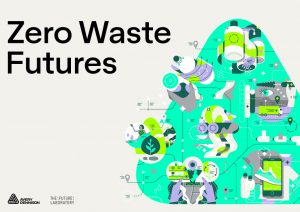Avery Dennison Corporation has teamed up with The Future Laboratory, a world-renowned futures consultancy, to compile the Zero Waste Futures report. Across the globe, two billion tons of waste are generated annually, according to The World Bank. This report provides brands and retailers with a strategic framework for action, and outlines a set of key drivers that will help accelerate solutions for a zero-waste future and the transition to a circular economy.
The report, available free of charge, draws on experts, features best-practice case studies and details three ‘futures’ scenarios around Biomimicry Materials, Lifecycle Visibility, and Circular Ecosystems. In addition, it details six immediate focus areas to drive the zero-waste transition:
- Eco-design where products are designed waste-free with end-of-life and recyclability built in at the beginning of the design process.
- Reframing waste as a valuable resource of raw materials.
- Increased focus on consumer education around recycling.
- New legislation to avoid or limit the generation of unnecessary waste.
- Industry and cross-sector collaboration to propel systemic change.
- Widespread adoption of technologies that enable end-to-end supply chain visibility.
Already a major concern, the proliferation of waste and environmental pollution has been exacerbated by the COVID-19 pandemic. In the US, containers and packaging comprise 28% of the waste that ends up in landfill, according to the US Environmental Protection Agency. In December 2020, an estimated three billion packages were shipped for Christmas in the US, an 800 million increase from the previous year.
Roughly one-third of food produced globally for human consumption each year – approximately 1.3 billion tonnes – gets lost or wasted; while textile waste is estimated to increase by about 60% between 2015 and 2030, with an additional 57 million tons of waste generated annually, reaching an annual total of 148 million tons.
Tyler Chaffo, manager, global sustainability, Avery Dennison Smartrac comments, “The sheer scale of global waste has created a renewed sense of urgency. We need cross-sector collaboration and a shared vision to drive system-wide change because the problem must be solved from multiple angles. Each sector will need to create calculations around the materials they use, their environmental impact, where waste occurs on the supply chain and where it can be eliminated for the most sustainable outcome.”
The combination of materials and digital solutions will play a critical role. A huge part of the problem is ‘invisible waste’ caused by poor inventory management and overproduction. Solutions such as unique digital IDs, which provide end-to-end supply chain transparency, can make the invisible waste visible, creating more efficient inventory management and allowing businesses to eliminate unnecessary waste.
Rob Groen in ‘T Wout, marketing manager, films, Avery Dennison Label and Packaging Materials comments, “Embedding circular mindsets, materials, technologies and processes within every stage of a product’s life can unlock the incredible potential of a zero-waste future. This can also contribute to other related sustainable development goals. The time to change the status quo has well and truly come.”
The launch of the report follows the announcement of atma.ioTM, a new digital venture from Avery Dennison that bridges physical and digital worlds. The new end-to-end platform will enable circularity by creating, assigning, and managing unique digital identities for every physical item in the world.










